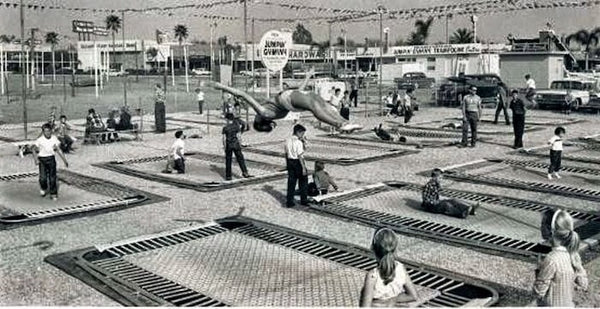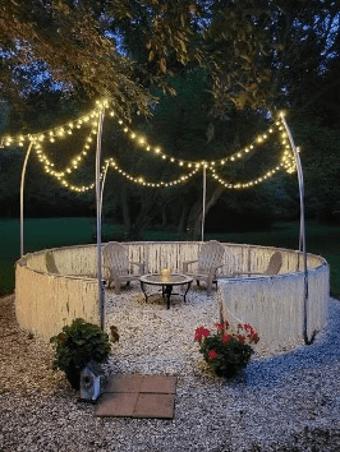29 Surprising Trampoline Facts You Never Knew
Bounce through history with our list of 29 astonishing trampoline facts. Discover trivia from WWII to NASA and beyond. Amaze your friends and family!
min read

You may not think it, but trampolines have a rich history.
From World War II to NASA to the Olympics, trampolines have an expansive reach beyond the backyard.
We’re going to use our decades of expertise and share with you 29 fun trampoline facts that you probably didn’t know.
Feel free to share these with your friends and family the next time you get together!
29 Fun Trampoline Facts
Below is our roundup of some super-cool trampoline facts:
1. The first prototype of a trampoline was created in the 1930s by George Nissen and Larry Griswold. Both were gymnastics competitors!
2. Nissen formulated the idea of a trampoline after attending a circus in 1930.
3. Trampolines have been used by the military to train pilots to respond to difficult air manoeuvres.
4. According to the Guinness Book of World Records, the highest trampoline bounce ever recorded is 6.73 m (22 ft 1 in).
 Photo courtesy of TODAY.
Photo courtesy of TODAY.
5. NASA found that 10 minutes of jumping burns more calories than 30 minutes of running.
6. NASA has also used trampolines to help astronauts with regaining balance after being in space.
7. Traditional trampolines use metal springs to provide the bounce. They are your classic backyard trampoline.
 Photo courtesy of Walmart.
Photo courtesy of Walmart.
8. Almost all trampoline mats are made from the same material: polypropylene.
9. Trampolining was officially introduced into the Olympics in 2000 at the Sydney Games.
10. The word trampoline has Spanish roots. It comes from the word “trampolín,” which means diving board.
11. The first springless trampoline was introduced in the early 2000s by our (Springfree Trampoline) inventor, Dr. Keith Alexander. They use fibreglass rods to replace the metal springs.
 Springfree Trampoline.
Springfree Trampoline.
12. Springfree Trampoline is the only trampoline type to eliminate 90% of product-related injuries.
13. The first trampoline park was built in 2004 (Sky Zone).
14. The largest trampoline park is Flip Out Trampoline Park, located in Glasgow, Scotland. It has 63,000 square feet of space!
15. Trampolines are not just for bouncing – there are lots of trampoline games and activities, like chalk drawing, that you can do!
16. In the 1950s, trampoline jumping became popular in the US, with dedicated “jump centres” appearing in some areas. While this trend didn’t take off in Australia at the time, trampolines steadily gained popularity in homes, schools, and gymnastics programs.
 Photo courtesy of Trampoline History Blog.
Photo courtesy of Trampoline History Blog.
17. There are trampolines built to be used on water – appropriately called water trampolines.
18. Mini trampolines (also called rebounders or exercise trampolines) became immensely popular in the early 1980s after the NASA Study was published. Rebounding still remains a popular form of exercise today.
19. Inground trampolines (installed into the ground) can cost over $5,000 to install in your backyard. It’s like installing a backyard swimming pool!

Photo courtesy of the Jump Shack.
20. The Guinness World Record for most consecutive somersaults is 3,333.
21. Trampolines used to be sold without enclosure nets. This changed around the 2000s; nowadays, you won’t find backyard trampolines sold without them.
22. Toddlers can jump too! Toddler trampolines are commonly sold and used throughout the world.
23. CHOICE® is Australia's leading consumer advocacy group, and the Springfree Medium Round Trampoline have been the CHOICE® Recommended Trampoline three years in a row.
24. An old trampoline can be turned into many things: a greenhouse, chicken coop, and even a nightly hangout spot!

Photo courtesy of Pinterest.
25. Trampolines have been shown to significantly improve motor proficiency and strength in children with Autism Spectrum Disorder (ASD).
26. Another Guinness World Record -- the most people jumping on a trampoline at one time is 376.
27. Even in a world full of screens, the trampoline market is still expected to grow at a Compound Annual Growth Rate (CAGR) of 4.62% (2022-2029).
28. The springs on a trampoline take up almost 60 cm of jumping space. So, a 4.3 m (14 ft) spring-based trampoline gives you around 3.7 m (12 ft) of actual jumping room.
29. Trampolines are versatile and able to be enjoyed by people of all ages. It’s not just people, either: even bears like to get their daily bounce in!
Video courtesy of CBC News.
The Best Trampolines of 2025
Trampolines are so much more than just a place to bounce.
As you have learned with these fun trampoline facts, the joy of bouncing on a trampoline has transcended generations.
Trampolines have come a long way since their invention in the 1930s.
New technologies and innovations have spurred many exciting trends for modern trampolines with options to suit all families.



